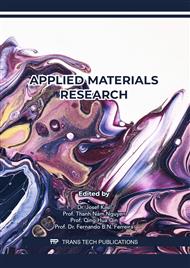[1]
S. Palanivel, C. Kuehmann, R. J. Stucki, E. Filip, and Edwards, Aluminum alloys for die casting, WO/2020/028730. U.S. Patent and Trademark Office. (2020).
Google Scholar
[2]
X. Li, A. Scherf, M. Heilmaier, and F. Stein, The Al-Rich Part of the Fe-Al Phase Diagram, Journal of Phase Equilibria and Diffusion. 37(2), (2016) 162–173.
DOI: 10.1007/s11669-015-0446-7
Google Scholar
[3]
Information on https://www.britannica.com/science/iron-chemical-element/Compounds, retrieved in Feb. (2021).
Google Scholar
[4]
L. Lu and A.K. Dahle, Iron-Rich Intermetallic Phases and Their Role in Casting Defect Formation in Hypoeutectic Al-Si Alloys, Metall. Mater. Trans. A, 36A (2005) 819-835.
DOI: 10.1007/s11661-005-0196-y
Google Scholar
[5]
M. Y. Murashkin, I., Sabirov, X., Sauvage, & R. Z. Valiev, Nanostructured Al and Cu alloys with superior strength and electrical conductivity, Journal of materials science. 51(1), (2016) 33-49.
DOI: 10.1007/s10853-015-9354-9
Google Scholar
[6]
W. D. Callister and D. G. Rethwisch, Materials science and engineering: An introduction. tenth ed. Hoboken, New York, (2020).
Google Scholar
[7]
Information on http://www.nde-ed.org/EducationResourse/CommunityCollege/Material/Physical_Chemical/Electrical.htm, retrieved in Feb. (2021).
Google Scholar
[8]
Information on https://materion.com/-/media/files/alloy/newsletters/technical-tidbits/issue-no-106---a-bridge-too-far---measuring-electrical-conductivity.pdf, retrieved in Feb. (2021).
Google Scholar
[9]
Information on http://eddy-current.com/conductivity-of-metals-sorted-by-resistivity/, retrieved in Feb. (2021).
Google Scholar
[10]
T. H. G. Megson, Structural and stress analysis, Butterworth-Heinemann, Oxfold, (2019).
Google Scholar
[11]
G. E. Totten, and D. S. MacKenzie (Eds.). Handbook of aluminum: vol.1: physical metallurgy and processes, Marcel Dekker, New York, (2003).
Google Scholar
[12]
N.P. Lyakishev, (ed.) Phase Diagrams of Binary Metallic Systems, Mashinostroenie, vol. 1, Moscow, 1996, pp.144-148.
Google Scholar
[13]
N. A. Belov, A. A. Aksenov, and, D. G. Eskin. Iron in aluminium alloys: impurity and alloying element, Taylor & Francis, London, (2002).
DOI: 10.1201/9781482265019
Google Scholar
[14]
A. Griger, V. Stefaniay, and T. Tunnezey, Z Metallkde., Chrystallographic data and chemical compositions of aluminiumrich Al-Fe intermetallic phases, Zeitschrift für Metallkunde. 77(1), (1986) 30-35.
Google Scholar
[15]
1. E. Hatch, (ed.), Aluminum: Properties and Physical Metallurgy, Metals Park, ASM. (1984).
Google Scholar
[16]
D. J. Skinner, M. Zedalis, Elastic modulus versus melting temperature in aluminum based intermetallics, Scr. Metall. 22(11), (1989) 1783-1785.
DOI: 10.1016/s0036-9748(88)80284-9
Google Scholar
[17]
D.G. Eskin, L.S. Toropova, Tensile and elastic properties of deformed heterogeneous aluminum alloys at room and elevated temperatures, Mater. Sci. Eng. A. A183 (1994) Ll-L4.
DOI: 10.1016/0921-5093(94)90913-x
Google Scholar
[18]
I. F. Kolobnev, Heat Resistance of Cast Aluminum Alloys, Metallurgiya, Moscow, (1973).
Google Scholar
[19]
V. I. Dobatkin, V. I. Elagin, and V. M. Fedorov, Rapidly crystallized aluminum alloys, VILS, Moscow, (1995).
Google Scholar
[20]
D. Liang, P. Korgul, and H. Jones, Composition and solidification microstructure selection in the interdendritic matrix between primary Al3Fe dendrites in hypereutectic Al-Fe alloys, Acta Mater. 44(7), (1996) 2999-3004.
DOI: 10.1016/1359-6454(95)00381-9
Google Scholar
[21]
S. Kasap, Springer handbook of electronic and photonic materials. Springer Science & Business Media, Wurzburg, (2006).
Google Scholar
[22]
A. Matthiessen, C, Vogt, On the influence of temperature on the electric conducting-power of alloys, Philos Trans R Soc Lond. 154 (1864) 167–200.
Google Scholar
[23]
L. Lu, Y. Shen, X. Chen, L. Qian, K. Lu, Ultrahigh strength and high electrical conductivity in copper, Science. 304 (2004) 422–426.
DOI: 10.1126/science.1092905
Google Scholar
[24]
F.l. Kvasov, L. N. Fridlyander (eds.), Commercial Aluminum Alloys, Metallurgiya, Moscow, (1984).
Google Scholar
[25]
L.F. Mondolfo, Aluminum Alloys: Structure and Properties, Butterworths, London, (1976).
Google Scholar
[26]
J.Y. Barghout, G.W. Lorimer, R. Pilkington, and P.B. Prangnell, in Proc. ICAA5, Mater. Sci. Forum, vols. 217-222, Zuerich, Transtec Publications, Part 2, Grenoble, 1996, pp.975-980.
DOI: 10.4028/www.scientific.net/msf.217-222.975
Google Scholar
[27]
T. Shikagawa, G. Itoh, S. Suzuki, H. Kuroda, and T. Horikoshi, Effect of small additions of Fe on the tensile properties and electrical conductivity of aluminium wires, Materials science forum Trans Tech Publications. 519 (2006) 515-518.
DOI: 10.4028/www.scientific.net/msf.519-521.515
Google Scholar
[28]
M. Jabłoński, T. A. Knych, and B. Smyrak, New aluminium alloys for electrical wires of fine diameter for automotive industry, Archives of Metallurgy and Materials. 54(3), (2009) 672-676.
Google Scholar
[29]
S. Kotiadis, A. Zimmer, A. Elsayed, E. Vandersluis & C. Ravindran, High Electrical and Thermal Conductivity Cast Al-Fe-Mg-Si Alloys with Ni Additions, Metallurgical and Materials Transactions A. 51 (2020) 4195–4214.
DOI: 10.1007/s11661-020-05826-w
Google Scholar
[30]
B.I. Bondarev, v.I. Napalkov, and V.I. Tararyshkin, Refinement of Wrought Aluminum Alloys, Metallurgiya, Moscow, (1979).
Google Scholar
[31]
J. Campbell, Castings, Butterworth Heinemann, Oxford, 2000, 74-78, 219-231.
Google Scholar
[32]
J. Campbell, Casting Practice – the 10 Rules of Castings, Butterworth Heinemann, Oxford, 2007, pp.120-175.
Google Scholar
[33]
T. Koutsoukis and M.M. Makhlouf, Alternatives to the Al–Si Eutectic System in Aluminum Casting Alloys, Int. J. Metalcast. 10 (2016) 342–347.
DOI: 10.1007/s40962-016-0042-6
Google Scholar
[34]
J.R. Davis, Aluminum and Aluminum Alloys, ASM Specialty Handbook, ASM International, Materials Park, USA, 2002, 723.
Google Scholar
[35]
J. Shin, S. Ko, K. Kim, Development and characterization of low-silicon cast aluminum alloys for thermal dissipation, Journal of Alloys and Compounds. 644 (2015) 673–686.
DOI: 10.1016/j.jallcom.2015.04.230
Google Scholar
[36]
S. Li, Hot Tearing in Cast Aluminum Alloys: Measures and Effects of Process Variables, PhD dissertation, Worcester Polytechnic Institute, USA, (2010).
Google Scholar
[37]
T. O. Mbuya, B. O. Odera & S. P. Ng'ang'a, Influence of iron on castability and properties of aluminum silicon alloys: literature review, Int. J. Cast Metal. Res. 16 (2003) 451–65.
DOI: 10.1080/13640461.2003.11819622
Google Scholar
[38]
D Apelian, Principles of Solidification, ASM Handbook Volume 15: Casting, ASM International, Materials Park, OH, USA, 2008, pp.267-376.
Google Scholar
[39]
J.A. Taylor, G.B. Schaffer, and D.H. StJohn, The Role of Iron in the Formation of Porosity in Al-Si-Cu–Based Casting Alloys: Part I. Initial Experimental Observations Metall. Mater. Trans. A., 30A (1999) 1643-50.
DOI: 10.1007/s11661-999-0101-1
Google Scholar
[40]
J.A. Taylor, G.B. Schaffer, and D.H. StJohn, The Role of Iron in the Formation of Porosity in Al-Si-Cu–Based Casting Alloys: Part II. A Phase-Diagram Approach, Metall. Mater. Trans. A. 30A (1999) 1651-55.
DOI: 10.1007/s11661-999-0102-0
Google Scholar
[41]
J.A. Taylor, G.B. Schaffer, and D.H. StJohn, The Role of Iron in the Formation of Porosity in Al-Si-Cu–Based Casting Alloys: Part III. A Microstructural Model Metall. Mater. Trans. A. 30A, (1999) 1657-62.
DOI: 10.1007/s11661-999-0103-z
Google Scholar


